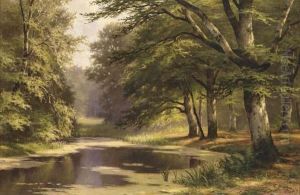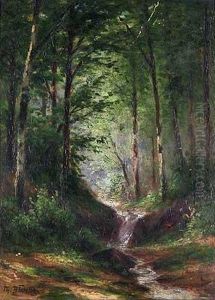Theodor Blache Paintings
Theodor Blache was a Danish landscape and portrait painter born on December 14, 1831, in Copenhagen, Denmark, and he passed away on December 2, 1900. Blache's artistic journey was deeply rooted in the rich cultural milieu of 19th-century Denmark, a period that was marked by a strong national romantic movement. He was part of a generation of artists who sought to capture the essence of the Danish landscape and the character of its people, contributing to the development of Danish national identity through art.
Blache studied at the Royal Danish Academy of Fine Arts in Copenhagen, where he was influenced by the teachings of Christoffer Wilhelm Eckersberg, known as the father of Danish painting. Eckersberg's emphasis on close observation of nature and the importance of plein air painting left a lasting impression on Blache. After completing his studies, Blache traveled extensively throughout Denmark, keen on capturing the country's diverse landscapes and seascapes. His works often depicted the serene beauty of the Danish countryside and coastlines, characterized by a refined use of light and color.
Though primarily known for his landscapes, Blache also excelled in portraiture, where he applied his keen observational skills to capture the personality and essence of his subjects. His portraits are noted for their realism and sensitivity, reflecting the individual character of each sitter.
Throughout his career, Blache exhibited his works in Denmark and abroad, gaining recognition for his contribution to Danish art. His paintings are part of the collections of several Danish museums, including the National Gallery of Denmark. Blache's legacy is that of an artist who captured the spirit of his time, contributing to the visual narrative of 19th-century Denmark through his landscapes and portraits. Despite the changing trends in art, Blache remained committed to his realistic approach, leaving behind a body of work that continues to be appreciated for its beauty and historical significance.

